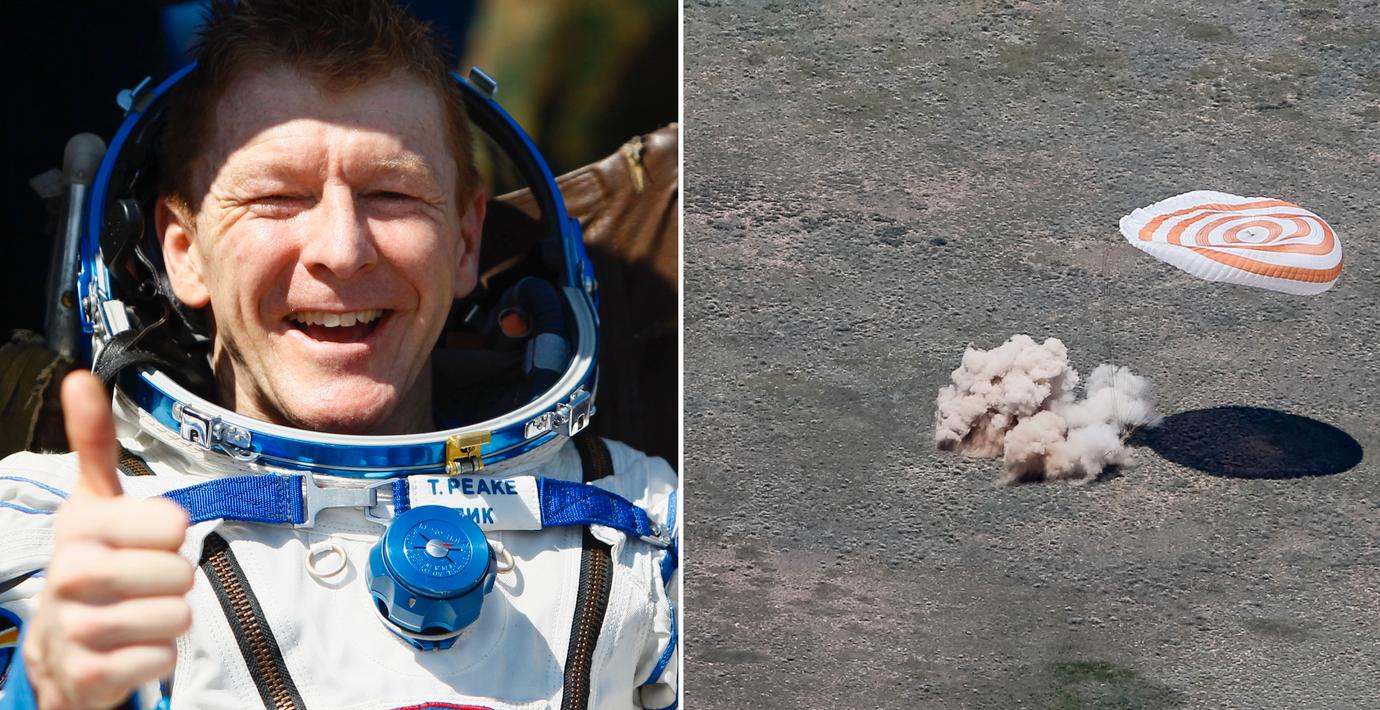
Efter ett halvår i rymden: ”Nu vill jag ha pizza”
Under sex månader har de tre astronauterna befunnit sig på den internationella rymdstationen ISS. Tidigare i dag lämnade de den och färdades mot jorden i en rymkapsel av märket Sojuz. Landningen skedde på stäppen i Kazakstan
– Mitt livs bästa resa, summerade britten Tim Peake.
Med ombord fanns också ryssen Jurij Malentjenko och Tim Kopra från USA .
– Snart vill jag ha pizza – och kanske en kall öl, sa Peake när han fördes bort från rymdkapseln.
bakgrund
Tim Peake är den förste som sprungit motsvarande ett maraton i rymden
Wikipedia (en)
Timothy Nigel Peake CMG (born 7 April 1972) is a British Army Air Corps officer, European Space Agency astronaut and International Space Station (ISS) crew member.
He is the first British ESA astronaut, the second astronaut to bear a British flag patch (the first was Helen Sharman), the sixth person born in the United Kingdom to go on board the International Space Station (the first was NASA astronaut Michael Foale in 2003) and the seventh UK-born person in space (the first was Helen Sharman, who visited Mir as part of Project Juno in 1991). He began the ESA's intensive astronaut basic training course in September 2009 and graduated on 22 November 2010.
bakgrund
ISS
Wikipedia (en)
The International Space Station (ISS) is a space station, or a habitable artificial satellite, in low Earth orbit. Its first component launched into orbit in 1998, and the ISS is now the largest artificial body in orbit and can often be seen with the naked eye from Earth. The ISS consists of pressurised modules, external trusses, solar arrays, and other components. ISS components have been launched by Russian Proton and Soyuz rockets, and American Space Shuttles.
The ISS serves as a microgravity and space environment research laboratory in which crew members conduct experiments in biology, human biology, physics, astronomy, meteorology, and other fields. The station is suited for the testing of spacecraft systems and equipment required for missions to the Moon and Mars. The ISS maintains an orbit with an altitude of between 330 and 435 km (205 and 270 mi) by means of reboost manoeuvres using the engines of the Zvezda module or visiting spacecraft. It completes 15.54 orbits per day.
ISS is the ninth space station to be inhabited by crews, following the Soviet and later Russian Salyut, Almaz, and Mir stations as well as Skylab from the US. The station has been continuously occupied for 7008493127381000000♠15 years and 229 days since the arrival of Expedition 1 on 2 November 2000. This is the longest continuous human presence in space, having surpassed the previous record of 7008314841600000000♠9 years and 357 days held by Mir. The station is serviced by a variety of visiting spacecraft: the Russian Soyuz and Progress, the American Dragon and Cygnus, the Japanese H-II Transfer Vehicle, and formerly the Space Shuttle and the European Automated Transfer Vehicle. It has been visited by astronauts, cosmonauts and space tourists from 17 different nations.
After the US Space Shuttle programme ended in 2011, Soyuz rockets became the only provider of transport for astronauts at the International Space Station, and Dragon became the only provider of bulk cargo return to Earth services (downmass capability of Soyuz capsules is very limited).
The ISS programme is a joint project among five participating space agencies: NASA, Roscosmos, JAXA, ESA, and CSA. The ownership and use of the space station is established by intergovernmental treaties and agreements. The station is divided into two sections, the Russian Orbital Segment (ROS) and the United States Orbital Segment (USOS), which is shared by many nations. As of January 2014, the American portion of ISS is being funded until 2024. Roscosmos has endorsed the continued operation of ISS through 2024, but has proposed using elements of the Russian Orbital Segment to construct a new Russian space station called OPSEK.
On 28 March 2015, Russian sources announced that Roscosmos and NASA had agreed to collaborate on the development of a replacement for the current ISS. NASA later issued a guarded statement expressing thanks for Russia's interest in future cooperation in space exploration, but fell short of confirming the Russian announcement.
Omni är politiskt obundna och oberoende. Vi strävar efter att ge fler perspektiv på nyheterna. Har du frågor eller synpunkter kring vår rapportering? Kontakta redaktionen